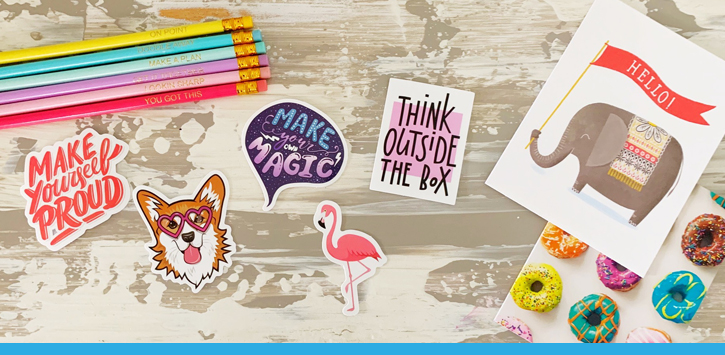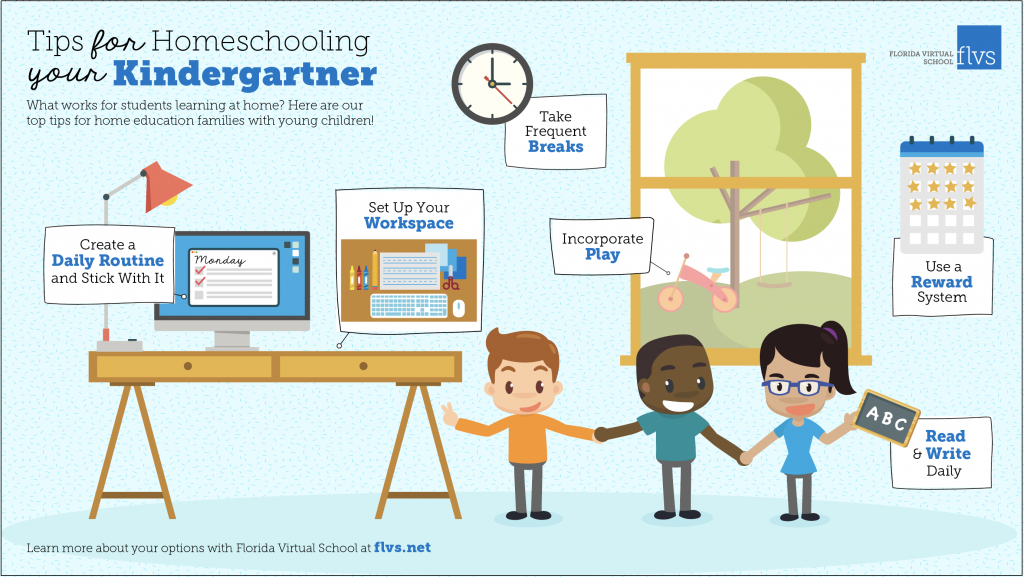8 Tips for Homeschooling Your Kindergartner

As a virtual Kindergarten teacher, I work closely with homeschool families. After spending three years in this role, I’ve seen firsthand what works for students learning at home. Read on for my top tips for home education families with young children!
Create a Weekly Schedule & Daily Routine
Children thrive when they have a routine and know what to expect. It will also help you, the home educator, be more organized. Plan out a daily routine: What time will you start school, take breaks, have lunch, and finish for the day? Try to keep it consistent each day. Some families like to get started first thing in the morning while others work better in the afternoon. Do what is best for your family! Also keep special activities and outings in mind (sports, music, park, field trips, etc.) when planning your weekly schedule.
Set Up Your Work Space
Create a space for your child to do his or her schoolwork. Your child will need a clean, organized, distraction-free area to work. You’ll also want to include the materials and resources needed most often while learning. View our video with tips for setting up your workspace, including some ideas for flexible seating.
Read & Write DAILY!
No matter which curriculum you’re using, you want to make sure that you’re incorporating reading and writing every day. Reading aloud to your children (even once they’re independent readers) is so important because this exposes them to fluent reading and great stories. I think it’s also important to incorporate different types of reading. Find a topic your child is interested in and research it together with a great nonfiction text. Read magazines, cookbooks, signs, etc. Words are all around us!
Also build in time to practice sight words. This doesn’t have to be flash cards! There are lots of fun ways to practice sight words. When it comes to writing practice, that can be fun, too! Before your child is writing, you can build in fine motor skills practice and drawing. Once your child is more skilled, he or she can write a note to a friend or family member, make a grocery list, or create a bedroom door sign.
Take Frequent Breaks
Especially in the primary grades, frequent breaks are important. I read that children can focus on a task for 2-5 minutes per year old. For our Kindergartners, that is 10-30 minutes, depending on the child. Keep this in mind when working through your lessons and allow them to have brain breaks as needed. This can be playing outside, dancing to a fun song, or an activity they love.
Keep a Portfolio
Remember to keep the work that your child completes throughout the year. Some families organize this in a large binder or file folder system by subject or chronologically. Make sure you know what your district’s end-of-year requirements are. Some will require you to have a portfolio, and if you’ve been adding to it all year, you’ll be good to go when you get to the end.
Go on Field Trips!
Many places offer discounts and special events/classes for homeschoolers. Look into your area and ask about these opportunities. It’s great to get the kids out for some real-life learning experiences. I also recommend visiting the library. It’s free and gives you the chance to swap out books from your home library.
Use a Reward System
Finding out what motivates your children can be helpful as they work through their school year. Coming up with a reward system can be a great motivation tool and make your life as a home educator easier. Students may be motivated by things like sticker charts, special outings, time to play their favorite games, etc. Once you know what will motivate them, build that in to your weekly schedule.
Incorporate Play
Especially at the Kindergarten age, play is so important. Through play, kids can develop their critical thinking, social skills, and problem-solving skills. Be sure to allow them time to play and allow time for it in your daily routine.
Above all, my biggest tip is to make learning FUN!
When kids are having fun and are engaged in what they’re learning, they’re more likely to retain this new information. Additionally, when kids are having fun, they’re likely to have positive feelings about school and learning. In Kindergarten, these experiences lay the foundation and set the tone for their school years to come. It’s so important to get off to a good start!
Check out our video below for more tips or save our infographic on Pinterest!
Want to learn more? Visit www.flvs.net/elementary.


 Cara Piper loves teaching Kindergarten students online with FLVS Flex Elementary! She is a teacher mama, grammar aficionado, blogger, and collector of creative headbands to keep her students engaged during Class Time. Follow her on Instagram @virtualelementaryteachers.
Cara Piper loves teaching Kindergarten students online with FLVS Flex Elementary! She is a teacher mama, grammar aficionado, blogger, and collector of creative headbands to keep her students engaged during Class Time. Follow her on Instagram @virtualelementaryteachers.
Structure is important for anyone, including adults and making home school an enjoyable engaging experience is just as important as doing the same thing within the confines of a school program on a campus. Everyone needs variety and enjoyable experiences to develop a positive culture for learning.
Great read!!! Thanks for sharing such a great blog.